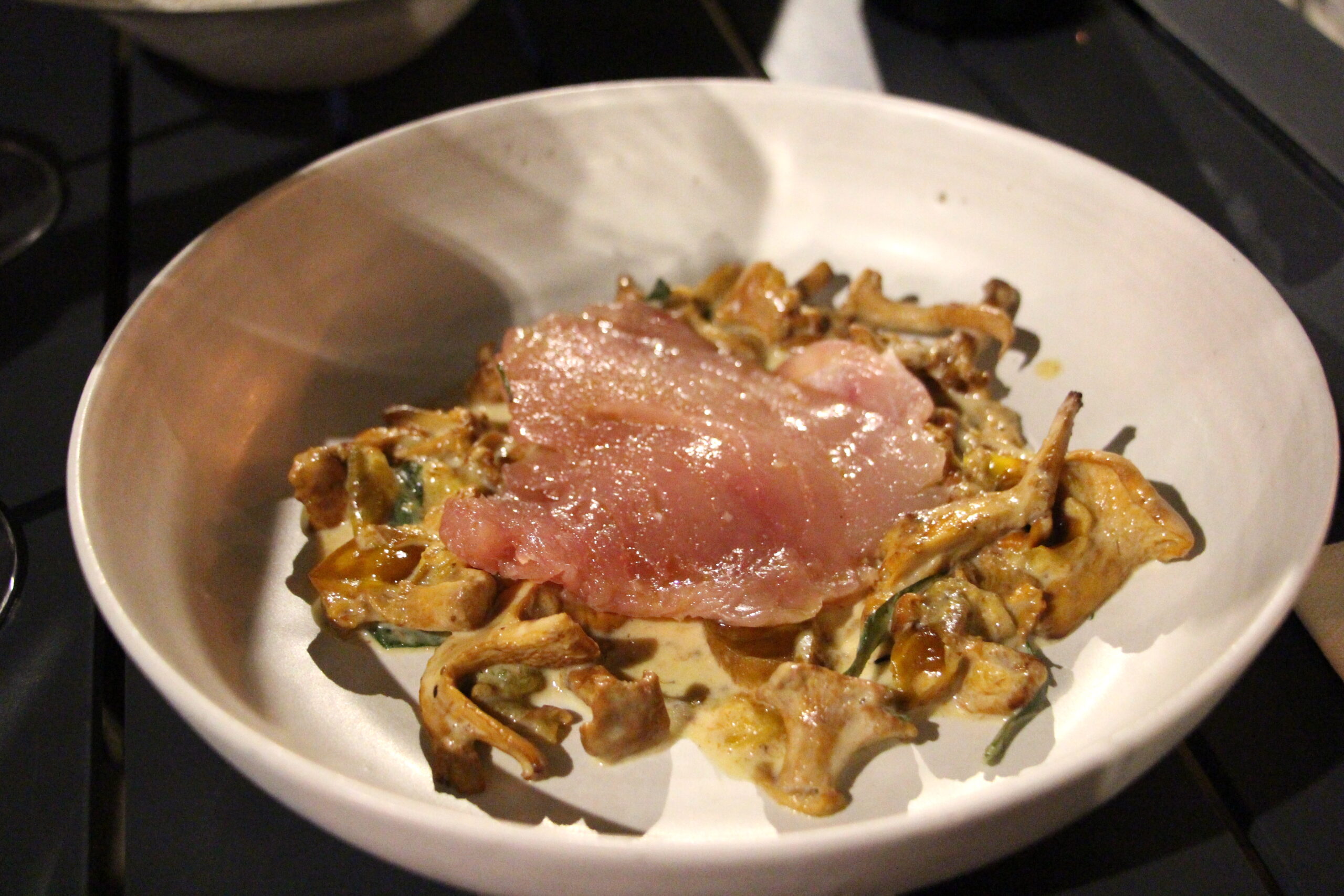I’ve been lucky enough to eat in quite a lot of fine dining spots in recent years, and one thing I’ve noticed is the division between food as nourishment and food as art. At certain Michelin-starred spots, audacity and creativity occasionally reign to the detriment of a given dish’s role, above all, as sustenance. The pleasure of dining in these places is more cerebral than it is visceral.
There was an element of that in my recent experience dining at Mokko, which in every other way is as run-of-the-mill a neo-bistro as they come. The floors are tiled; the pale wood tables are bare. The menu is scrawled in white chalk on a black chalkboard: just three appetizers, two mains, and two desserts. But there’s something so incredibly creative going on in the kitchen here, where some dishes are out-there enough as to prove divisive. But when it lands, this place is pretty extraordinary.
The appetizer course illustrates exactly this discrepancy, with the smoked watermelon dish (14) taking the role of divisive. I’m already not the biggest fan of watermelon in cooked or cured form, seeing as while I love the flavor of watermelon, its texture is really what does it for me, with its bright toothsomeness and moisture. The second it’s cooked or tampered with in any way, I find watermelon becomes flabby, emulating the texture it takes on when it has sat in the fridge too long, bordering on insipid.
In this dish, the smoked watermelon was paired with not-quite-enough feta and slightly too much mint, which was infused into a goat milk that I loved and my dining companion didn’t. With green onion, fig, and sun-dried tomato competing with the mild watermelon, there was a bit too much going on, especially for my friend, who isn’t a huge fig fan to begin with. And while I liked the chile kick and the lactic broth, the texture of the watermelon made it a tough one for me to swallow.
The raw white tuna (14) was no less audacious yet far better received. A sweet-and-savory autumnal jumble of chanterelle mushrooms and mirabelles sat in a puddle of smoked hay cream. And while the promised trout eggs were nowhere to be found, the silken tuna was a wonderful and surprising topping, transforming the earthy medley with its welcome brininess. I loved the sweet-and-savory flavors of this dish as well as the creativity of the pairing. A total winner in my book.
We were far more unanimously happy with our mains, like this duck breast (24) with aubergine, quetsche plum, plum coulis, beef reduction, and anise-infused beet. Duck loves sweet flavors, and I enjoyed the revamp of the more classic orange or honey pairings with this autumnal approach. My only criticism was of the duck itself, which was tough enough to require quite a bit of sawing.
I was initially less gung-ho about the fish of the day (27) as described on the menu. The duck just seemed so much more exciting! But seeing as I’m one of those people who cannot order the same main as my dining companion (especially when there are only two choices on offer), I opted for the sébaste, and I was not disappointed. The fish was served on a generous tumble of last-of-the-season courgettes and tomatoes, with a slow-cooked courgette jam spread underneath. A rich mustard- and lovage-spiked cream sauce was silky and smooth, boasting almost curried vibes. This dish boasted another technical hiccup, seeing as the fish skewed slightly undercooked, but at the end of the day, I’d prefer that than over, and the flavors made up for it.
With two desserts on the menu, the obvious choice was to grab one of each and share. The fruit dessert (10) was far more up my personal alley, with roasted and raw figs and plums scattered atop a rose-infused pastry cream. I’m not usually a fan of floral desserts – I find them a little perfumey – but the rose here was quite subtle, and the sablé biscuit over the top added just the right amount of welcome crunch.
Chocolate mousse (10) is everywhere these days, but this one was pretty exceptional. Made with 80% dark chocolate and served in a generous bowl topped with cacao nibs and flaky salt, it was rich without being cloying and the perfect final bite.
As my friend and I sat sipping the last of the funky German pinot blanc we’d ordered, we considered how we would recommend Mokko. Both of us liked it quite a bit, but neither of us thought we’d be willing to cross Paris for it. Ultimately, I think it’s the kind of place you’d love to have around the corner from you, if you wanted to try something special, and diners who feel as though there’s a lot of same-old same-old happening on the Parisian dining scene should head here for some more surprising flavor combos.
Mokko – 3 Rue Francœur, 75018 Paris






